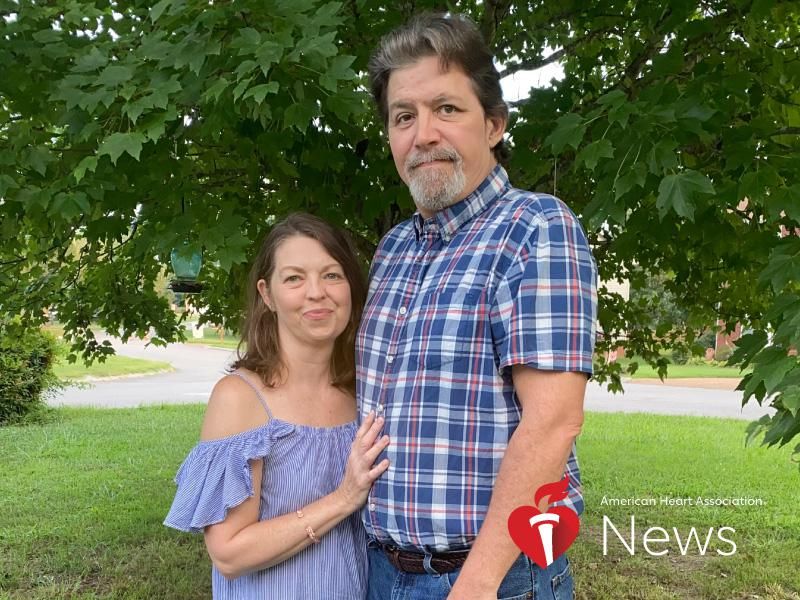FRIDAY, Aug. 20, 2021 (American Heart Association News) — As Mark Davis slowly woke up, he shuddered over the terrible dream he’d just experienced. In it, he had no feeling in his right side and each breathe was a struggle.
He was relieved to leave it behind as he thought about getting up and going to work.
Except, he couldn’t move.
It wasn’t a dream. He was in a hospital bed with a breathing tube down his throat.
His wife, Lisa, was in the room. So were nurses and a doctor.
Mark heard the doctor tell Lisa that a series of strokes left her husband with locked-in syndrome. Mark had recently seen a television show that included the neurological disorder. So he knew it meant he could be paralyzed except for his eye muscles. He could think, but not speak or move.
The doctor told Lisa all the things Mark wouldn’t be able to do – that is, if he survived. He braced her for a best-case scenario of life in a long-term care facility, breathing with a ventilator.
“That is not what my life is going to look like,” Mark wanted to tell his wife of 30 years. But he could only make that promise to himself.
Mark first noticed a problem in July 2019. While trap shooting in a remote area of Tennessee, he felt so weak and dizzy that he thought he was going to pass out. Minutes later, he felt fine.
Those symptoms played out almost daily, although milder. Yet sometimes they included double vision.
“The truth is, I didn’t take care of myself at all,” said Mark, who was then 54. “I didn’t eat well, I drank too much and I could have lost 20 or 30 pounds. My cholesterol was always a little high for like 20 years.”
Never one to see a doctor, he was frightened enough to see a general practitioner. He was prescribed migraine medication. The medication wasn’t helping, so he requested an appointment with a neurologist. However, that visit was six weeks away, on Oct. 30.
The evening of Oct. 29, Mark felt weak and nauseous. His eyes shifted left and stayed there. To walk straight, he had to turn his head to the right.
He called for Lisa.
At the hospital, a CT scan showed Mark was having a stroke. He was given clot-busting medication and transferred to a larger hospital in nearby Nashville for more specialized care.
During the ambulance ride, Mark had a second stroke and lost movement in his right side. In the emergency room, he had a third stroke, which paralyzed his diaphragm and stopped his breathing.
Doctors told Lisa that Mark had experienced a series of brain stem strokes, and likelier smaller strokes earlier. The brain stem controls all basic activities of the central nervous system – consciousness, blood pressure, breathing and motor control.
Doctors also said she might have to decide whether to take him off the ventilator.
“They didn’t give me any hope,” Lisa said. “But I just blocked them out. I wasn’t ready.”
Neither was Mark.
Three days later, one of Mark and Lisa’s three daughters noticed her father’s left thumb twitch. She excitedly called for a doctor.
“It’s just a reflex,” the doctor said.
It happened again.
“It’s not just a reflex,” Lisa insisted. “He’s trying to get our attention.”
Finally, Mark thought. Someone is listening.
He hated that they talked as if he couldn’t hear them.
From that moment on, he said later, “I took every negative word those doctors said as motivation.”
His family posted a sign on his hospital door saying, “Negative-free zone. Positive conversations only, please.” Mark is convinced that was the key to his recovery.
With a speech therapist, Mark began to communicate with eye movement.
After two weeks, he was transferred – not to a long-term care facility, but to a rehabilitation facility, where Lisa would learn how to care for him.
When Dr. Antoinne Able walked in to meet the couple, Mark gave him a half thumbs-up.
“Dr. Able got really excited,” Lisa said. “They hadn’t expected that.”
Mark and Lisa celebrated many milestones during his rehabilitation, but Lisa’s favorite was when she heard him use his nickname for her: Sweet Pea.
Mark’s most memorable moment came when he was being taught to use a slide board to transfer from one spot to another. When asked to start moving, Mark “just kept going,” he said.
Eventually, he astonished everyone – including himself – by standing.
When he left the hospital on Dec. 31, he took several steps on his own with a walker on the way to his car.
Once home, Mark went regularly to outpatient rehab, working on his speech, gait, coordination and strength. In June, he returned to work as a network engineer.
Today, Mark feels he is about 85% recovered. He continues to work on vision and balance. He also struggles with uncontrollable bouts of crying.
Able calls Mark’s recovery “truly incredible.”
“While a good many survive this catastrophe, only a few will actually return to work,” Able said.
Mark feels the stroke has made him more patient and less judgmental.
“My thinking used to be, ‘Lead, follow or get out of the way.’ I understand now that that’s not always possible.”
American Heart Association News covers heart and brain health. Not all views expressed in this story reflect the official position of the American Heart Association. Copyright is owned or held by the American Heart Association, Inc., and all rights are reserved. If you have questions or comments about this story, please email editor@heart.org.
By Diane Daniel
Copyright © 2025 HealthDay. All rights reserved.

